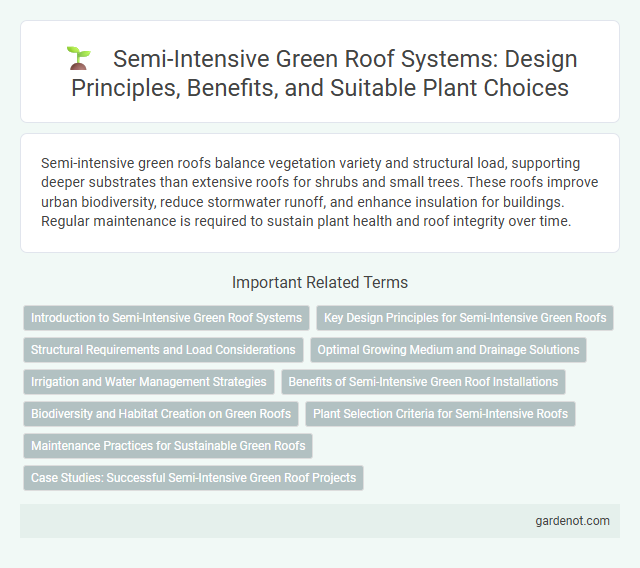Semi-intensive green roofs balance vegetation variety and structural load, supporting deeper substrates than extensive roofs for shrubs and small trees. These roofs improve urban biodiversity, reduce stormwater runoff, and enhance insulation for buildings. Regular maintenance is required to sustain plant health and roof integrity over time.
Introduction to Semi-Intensive Green Roof Systems
Semi-intensive green roof systems balance aesthetic appeal and functional benefits by combining a diverse range of hardy vegetation with moderate substrate depths, typically between 8 to 15 centimeters. These systems support shrubs, grasses, and perennials, offering improved biodiversity and enhanced stormwater management compared to extensive roofs. Commonly used in urban environments, semi-intensive green roofs provide better insulation, reduce urban heat island effects, and contribute to building energy efficiency while requiring moderate maintenance.
Key Design Principles for Semi-Intensive Green Roofs
Semi-intensive green roofs require a balanced substrate depth between 6 to 12 inches to support a diverse range of vegetation, including grasses, shrubs, and small trees. Proper irrigation systems are essential to maintain moisture levels, especially during dry periods, while ensuring adequate drainage to prevent waterlogging. Structural load capacity must be considered carefully, as semi-intensive roofs typically weigh between 70 to 150 pounds per square foot when saturated.
Structural Requirements and Load Considerations
Semi-intensive green roofs require careful structural assessment due to their moderate substrate depth, typically ranging from 8 to 15 centimeters, which supports diverse plant species including grasses, perennials, and small shrubs. Load considerations must account for the saturated soil weight, irrigation systems, and additional live loads such as foot traffic, generally necessitating a roof structure capable of supporting 150 to 250 kg/m2. Engineering evaluations focus on waterproofing integrity, root barrier installation, and drainage layers to maintain roof longevity and performance under increased weight conditions.
Optimal Growing Medium and Drainage Solutions
Semi-intensive green roofs require an optimal growing medium that balances adequate moisture retention with sufficient aeration to support diverse plant species including sedums, grasses, and shrubs. High-quality drainage solutions such as layered substrates combined with synthetic drainage mats ensure excess water is efficiently managed, preventing root rot while promoting healthy plant growth. Selecting lightweight, nutrient-rich media with engineered drainage systems enhances the roof's structural integrity and long-term sustainability.
Irrigation and Water Management Strategies
Semi-intensive green roofs require moderate irrigation systems tailored to plant species with medium water needs, optimizing runoff retention and minimizing water waste. Utilizing moisture sensors and drip irrigation technology enhances water efficiency by delivering precise amounts directly to the root zone. Integrating rainwater harvesting and automated irrigation schedules ensures sustainability while supporting plant health and reducing overall water consumption.
Benefits of Semi-Intensive Green Roof Installations
Semi-intensive green roof installations offer a balanced combination of aesthetic appeal and environmental functionality by supporting a diverse range of plant species, including shrubs and grasses, which enhance biodiversity and improve urban microclimates. These green roofs provide effective rainwater management by reducing runoff and improving water retention, contributing to flood mitigation and decreased strain on drainage systems. Furthermore, semi-intensive green roofs improve building insulation, leading to energy savings by regulating indoor temperatures and extending roof membrane lifespan.
Biodiversity and Habitat Creation on Green Roofs
Semi-intensive green roofs enhance urban biodiversity by providing diverse habitats that support pollinators, birds, and insects through a mix of shrubs, grasses, and perennials. These green roofs create valuable ecological niches, promoting species richness and ecosystem resilience in densely built environments. Incorporating native plants further maximizes habitat value, fostering local wildlife and contributing to urban green infrastructure biodiversity networks.
Plant Selection Criteria for Semi-Intensive Roofs
Semi-intensive green roofs require a balanced selection of plants that tolerate moderate substrate depths, typically between 8 to 15 centimeters, supporting a variety of sedums, grasses, herbs, and small shrubs. Plant species must demonstrate drought resistance, root system adaptability to shallow soils, and tolerance to rooftop microclimates including wind exposure and temperature fluctuations. Prioritizing native and low-maintenance vegetation enhances biodiversity, reduces irrigation needs, and improves the overall sustainability of semi-intensive green roof systems.
Maintenance Practices for Sustainable Green Roofs
Semi-intensive green roofs require balanced maintenance practices, including regular irrigation, fertilization, and weed control, to ensure plant health and system longevity. Monitoring drainage systems and inspecting substrate depth helps prevent waterlogging and structural damage. Implementing sustainable maintenance protocols promotes biodiversity while reducing resource consumption for long-term environmental benefits.
Case Studies: Successful Semi-Intensive Green Roof Projects
Semi-intensive green roofs have demonstrated notable success in urban environments, as evidenced by the Aquaverde Project in Germany, which improved stormwater management by 40% and increased building insulation efficiency by 25%. The University of Toronto's Centre for Engineering Innovation exemplifies energy savings of up to 20% through its semi-intensive green roof design combining drought-tolerant sedums with native grasses. Case studies consistently highlight the balance semi-intensive green roofs offer between biodiversity enhancement and structural load feasibility, making them ideal for mid-rise commercial and institutional buildings.
Semi-intensive green roof Infographic

 gardenot.com
gardenot.com